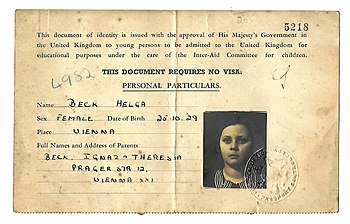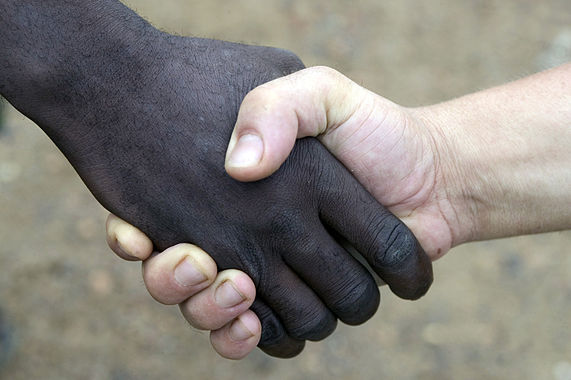Cultural Anthropology/Anth Perspective/Identity

Identity is constructed and influenced by many things, including gender, sex, norms, etc. In this section, you will
- explore the construction of identity
- learn the difference between sex and gender
- examine the "third gender"
- investigate ethnicity, race, and racism
Contents
Key Terms & Concepts
- Enculturation
- Rite of passage
- Sex
- Gender
- Gender role
- Gender stereotypes
- Gender stratification
- Ethnicity
- Ethnic group
- Situational negotiation of identity
- Race
Culture and Identity
What values do you hold? What clothes do you like to wear? Who do you think you are? Culture impacts the answer to each of these questions. Our identities are constructed within specific cultural contexts. Frequently, people self-identify as a member of a particular religion or nation or gender. We draw on those things we learn over our lifetime to become the people we are today. Who we are changes over time as we learn new things and encounter new people. In this section, we focus on how our earliest identities are formed and two concepts related to identity that many people think are simple, but in fact can be complicated: gender and race/ethnicity.
Enculturation
When we are born, we are totally dependent upon others for our survival. For years, human children are dependent upon someone else to care for them. In fact, among the primates, humans have the longest period of childcare. During these years, children constantly learn about their culture. This process of being socialized into culture we live within is called enculturation. Enculturation starts immediately after birth and continues throughout our lives. Enculturation occurs both informally and formally. Informally, through the process of observation and listening, we learn language and cultural rules.
Because we learn most of our cultural rules unconsciously, we come to feel that our behavior is natural, a result of our nature rather our culture. And because we feel that our behavior, attitudes, and values come from our nature, we generally don’t question their appropriateness. Instead, we “naturalize” our culture, taking these behaviors and attitudes as part of our nature rather than recognizing their cultural origins (Bonvillain 2010: 95).
Because we tend to view our behaviors, attitudes, and values as natural, we rarely question them and view those in the culture who do question them as rebels or troublemakers. We can easily become offended when these things are challenged, and may react passionately or even violently in order to defend our behaviors, attitudes, and values. We may view different behaviors, attitudes, and values as “weird” or “unnatural” simply because they are not like our own. This is where the practice of cultural relativism is beneficial as it encourages us to try and understand those behaviors, attitudes, and values that are different from our own.
Informal enculturation can occur by observing the actions of parents, siblings, or other family and friends. It can occur through the toys that a child is encouraged to play with, e.g., in industrial societies young girls are encouraged to play with “dolls,” while young boys play with “action figures.” Recently there has been a societal backlash against the genderization of toys and clothing for children. The topic is being explored at multiple levels: academically: JeongMee Yoon’s The Pink & Blue Project, institutionally: the She-Culture project sponsored by the EU Culture Programme 2007-2103, in the popular press: Kindergarten Fashion, and by individuals: Tree Change Dolls.
Formal enculturation occurs through schools, churches, and other institutions. The K-12 system in the United States uses formal education to train children in their roles as citizens of the U.S. It instills norms beneficial for a capitalist society: competition (for grades) and conformity (to authority). Formal learning can also occur through trade apprenticeships where skills and submission to authority are instilled. The age where children can begin to work varies from country to country. Conditions are often dangerous and many nations implemented child labor laws to address the exploitation of children.
Culturally “correct” behavior can be taught through nursery rhymes, children’s books, religious doctrine, and rites of passage. A rite of passage is a ritual that commemorates a significant transition, e.g., childhood to adulthood, marriage, birth, and death. It moves an individual from one social status to another. During the ritual, the individual learns about the behaviors, attitudes, and values that are appropriate for their new role. Initiation rites, or rites that mark the acceptance of a person into a group, can be particularly influential in shaping identity by providing guidelines on how to think about one’s self. Initiation rites can:
- Weed out those not willing to conform to the group’s behaviors, attitudes, and values,
- Create a sense of self-doubt, discord, or disconnectedness that results in a willingness to learn from and accept the group,
- Create a sense of obligation and thankfulness that ties the individual to the group,
- Create a sense of accomplishment and inclusion when a person successfully completes the initiation rites, and
- Create bonds between the initiates who went through the experience together.
There are numerous examples of rites of passage, including coming of age rituals (bar and bat mitzvah, quinceañera, okuyi), marriage, graduation, wiccaning, and pilgrimage. Enculturation does not stop once we reach a certain age. It continues throughout our life as we reach new age statuses or milestones such as parenthood or start a new job.
Gender
The enculturation process informs us of our expected gender roles. Gender is different than sex. Sex is a biological state of being generally based on the observable genital characteristics. There is some debate on the actual number of biological sexes; female, male, and intersex are more commonly identified, but there are some researchers using genetic status as the indicator, e.g., XX, XY, XXX, XO, and XXY (for a short discussion of intersex, visit ISNA; for a longer discussion visit PBS). Gender is the “…cultural construction of whether one is female, male, or something else” (Gezen and Kottak 2014: 146). A gender role consists of the norms and values assigned to the sexes. Gender stereotypes are prevalent among cultures and are generalizations about the characteristics of the sexes. Cultural groups may have specific ideas about which sex has more access to resources, e.g., wages, prestige, personal freedom, leading to unequal distribution of rewards or gender stratification.
Gender enculturation begins immediately after birth. It occurs in how children are spoken to and treated. As mentioned previously, it occurs in how children are dressed and which toys with which they are given for play. In the United States, mainstream society traditionally recognizes two genders: male and female. In the 21st-century, there is a growing movement to recognize a third gender, transgender, a designation for people who feel that they are neither gender, both genders, or that their biological sex does not indicate how they feel about their gender. In other cultures, other genders have been recognized and incorporated into the norm. The hijra of India are one example. Hijra “…are culturally defined as “neither men nor women” or as men who become women by adopting women’s dress and behavior” (Nanda 2015: 96). In Samoa, men who live as women are called fa’afafine and fulfill traditional female roles. Sworn virgins are biological females born into some Balkan societies who take on traditional male roles when there is a shortage or men, a concept similar to the virginal transvestites in North Albania. In many Native American societies we find the two-spirit persons who, traditionally, some considered sacred, as they possessed the spirit of both male and female. While many third gender persons face still discrimination and ostracism, there is a growing global movement to stop such actions.
Ethnicity & Race
Human beings seem to have an innate need to classify, perhaps due to the sheer volume of information that must be processed on any given day. This need extends beyond the need to classify the natural world around them, but to classify other human beings as well. In doing so, clear lines are drawn between themselves and others. These lines serve to identify to whom we have social obligations and with whom we are competing for resources. Culturally, two ways to do this is through identification of an individual’s ethnicity or race.
Ethnicity refers to an ethnic group that a person identifies with or feels a part of to the exclusion of other groups. An ethnic group shares similar values and norms defined by such things as language (e.g., Hispanics), geography (e.g., Somalis), religion (e.g., Jews), or race (see discussion of race below). While this seems like a straightforward concept, it can be murky. Children of parents of different ethnicities may perceive themselves one way and others perceive them as something else. This can occur even among the siblings of or between generations in mixed-ethnic families.
Ethnic identity is tied to social status, therefore, a person’s ethnic identity may change depending on the context, where one ethnic identity is used in certain contexts and a different identity is used in another context. This is called the situational negotiation of identity. Gezen and Kottak (2014: 215) discuss Hispanics as an example of situational negotiation of identity. “Hispanic” as noted above is an ethnic identity based primarily on language. It includes people of varying skin color and geography. When issues impacting all Hispanics arise in the United States, people who identify as Mexican American, Cuban American and Puerto Ricans may act together to address the issue. At other times, they identify as peoples with different interests; e.g., Mexican Americans may be interested in immigration reform, Puerto Ricans on statehood, and Cuban Americans on lifting of trade sanctions on Cuba. Ethnic identity is often tied directly to the sociopolitical hierarchy of a country. Ethnic groups become equated with minority groups who have less power and prestige then the majority group. Ethnic groups are frequently confused with races. Race is cultural construct that groups people together based on perceived biological similarities. In the biological sciences, a race is a “geographically related subdivision of a species” (Gezen and Kottak 2014: 216). This definition does not apply to Homo sapiens. Genetically, it is clear that human groups have been interbreeding for millennia as at a genetic level we are similar to one another. This is not to say that there is no diversity in human beings; one only has to look around to see some variability, but at a genetic level the diversity we see is, well, superficial.
This tendency to group peoples together based on a perceived similarity is not a new phenomenon. The ancient Greek philosopher, Hippocrates (460-370 BC), wrote about the essences of organisms, or humors, that determined its physical traits, temperament, intelligence, and behavior (Brown 2010: 66). Building off of Aristotle’s scale of nature, medieval Europeans created an immutable, or unchanging, “great chain of being” to categorize the world, placing themselves near the top of the chain following only angels and God, with the rest of humanity categorized below. This approach is referred to as the essentialist approach.
During the late Renaissance and Enlightenment periods, philosophers and scientists continued to try to categorize human beings. French philosopher Jean Boudin (1530-1596) followed the Greeks in using humors coupled with skin color to classify humans. In Boudin’s schema white-skinned Europeans had a predominance of phlegm and were both reflective and rational. Black-skinned Africans had black bile and were lethargic and less-intelligent than other peoples. Red-skinned Indians were savage, war-like, and associated with blood, while Asians were associated with yellow bile, yellow skin, deviousness, and slyness. Carolus Linneaus (1707-1778) used a similar system when creating his scientific classification system in the 1700s.
Anthropology has contributed to the tenacity of the race concept throughout the years. Johann Friedrich Blumenbach (1752-1840), the father of physical anthropology, rejected external characteristics such as skin color to focus on skull shape to create five types: Caucasian, Mongolian, Malayan, Ethiopian, and American. Shortly after Blumenbach published his schema, skin color was attached to each of the racial types: white, yellow, brown, black, and red. Franz Boas (1858-1942) was the first anthropologist to challenge the essentialist approach. He pointed out essentialist schemes were based on the faulty assumption that there was a connection between skin color and temperament. In fact, no biological connection between skin color and temperament had ever been demonstrated. Boas argued that natural and cultural environment were keys to shaping behavior. Conducting a study of Sicilian immigrants over a ten-year period, Boas demonstrated that both behavior and biological characteristics could change based on the natural and cultural environment. The debate on and research into the usefulness, accuracy, and efficacy of the race concept continues. While all anthropologists acknowledge the inherent flaws in the concept, primarily that there are no biological human races, forensic anthropologists use the concept to help law enforcement identify human remains. Forensic anthropologists use measurements from multiple features of the skeleton to predict biological affiliation. Nonetheless, most American anthropologists support the American Anthropological Association’s position on race:
In the United States both scholars and the general public have been conditioned to viewing human races as natural and separate divisions within the human species based on visible physical differences. With the vast expansion of scientific knowledge in this century, however, it has become clear that human populations are not unambiguous, clearly demarcated, biologically distinct groups. Evidence from the analysis of genetics (e.g., DNA) indicates that most physical variation, about 94%, lies within so-called racial groups. Conventional geographic "racial" groupings differ from one another only in about 6% of their genes. This means that there is greater variation within "racial" groups than between them. In neighboring populations there is much overlapping of genes and their phenotypic (physical) expressions. Throughout history whenever different groups have come into contact, they have interbred. The continued sharing of genetic materials has maintained all of humankind as a single species (American Anthropological Association 1998).
The complete statement is available from the American Anthropological Association.
One may wonder that if there are no biological human races, why does the concept persist? It persists because people live the experience of race. What this means is that people discriminate based on appearance, which includes not only skin color, but language, social behavior, etc.
We tend to separate people into ethnic categories, but we often use racial terms to identify these categories. Thus, one talks about “black” culture or “white” culture as if the color of one’s skin is somehow connected to one’s behavior. While the connection is clearly not genetic, it is real nonetheless. An example can be found in the 2008 presidential election when then-candidate Obama was criticized by some leaders in the African American community for not being “black enough.” Clearly, they were not talking about his skin color, but rather his lived experiences as a person of color. Obama didn’t go through the “typical” black experience of discrimination and the social injustice that goes along with it, because he was raised by a white family in biologically and ethnically diverse Hawaii... Using racial labels like “black” or “white” as shorthand for ethnic experiences may be useful and even necessary for Americans when talking about race. However, it also keeps alive the centuries-old essentialist notions about race and behavior (Brown 2010: 74).
As we have learned, there are many things that contribute to our personal identities. Cultural concepts about ethnicity, race, and gender create boxes that we are expected to operate within. Breaking free from those expectations can be a difficult and painful process as we place others into unfamiliar territory where their cultural expectations are negated. This creates conflict for all parties involved because of fear of the unknown; however, the end result can be one of change for the whole society not just the individuals involved.
References
American Anthropological Association. “Early Classification of Nature.” Race, accessed April 15, 2015. http://www.understandingrace.org/history/science/early_class.html.
American Anthropological Association. “American Anthropological Association Statement on “Race” (May 17, 1998).” Accessed April 15, 2015. http://www.aaanet.org/stmts/racepp.htm.
Ashforth Blake E., and Kristie M. Boudwin. “Initiation Rites.” In Encyclopedia of Group Processes & Intergroup Relations, edited by John M. Levine and Michael A. Hogg, 448-451. Thousand Oaks, CA: SAGE Reference, 2010.
Bonvillain, Nancy. Cultural Anthropology, 2nd edition. Boston: Prentice Hall, 2010.
Brown, Paul F. “Race and Racism.” In 21st Century Anthropology: A Reference Handbook, Vol. 1, edited by H. James Birx, p. 65-75. Thousand Oaks, CA: SAGE Reference, 2010.
Davis-Floyd, Robbie. “Rites of Passage.” In International Encyclopedia of the Social Sciences, 2nd edition, Vol. 7, edited by William A. Darity, Jr., 256-259. Detroit: Macmillan Reference USA, 2008.
Devor, Aaron H. “How many sexes? How many genders? When two are not enough.” Last modified June 29, 2007, http://web.uvic.ca/~ahdevor/HowMany/HowMany.html.
Fernandes, Luci. “Enculturation.” In Encylopedia of Anthropology, Vol. 2, edited by H. James Birx, p. 810-811. Thousand Oaks, CA: SAGE Reference, 2006.
Gezen, Lisa, and Conrad Kottak. Culture, 2nd edition. New York: McGraw-Hill, 2014.
Markowitz, Harvey. “Berdache.” In American Indian Culture, edited by Carole A. Barrett and Harvey J. Markowitz, p. 128-130. Pasadena, CA: Salem Press, 2004.
Nanda, Serena. “Hijra.” In Encyclopedia of World Cultures, Vol. 3: South Asia, p. 96-98. New York: Macmillan Reference USA, 1996.


